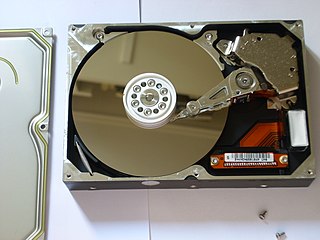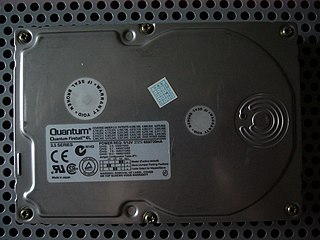
Disk storage is a general category of storage mechanisms where data is recorded by various electronic, magnetic, optical, or mechanical changes to a surface layer of one or more rotating disks. A disk drive is a device implementing such a storage mechanism. Notable types are the hard disk drive (HDD) containing a non-removable disk, the floppy disk drive (FDD) and its removable floppy disk, and various optical disc drives (ODD) and associated optical disc media.

A hard disk drive (HDD), hard disk, hard drive, or fixed disk is an electro-mechanical data storage device that uses magnetic storage to store and retrieve digital information using one or more rigid rapidly rotating disks (platters) coated with magnetic material. The platters are paired with magnetic heads, usually arranged on a moving actuator arm, which read and write data to the platter surfaces. Data is accessed in a random-access manner, meaning that individual blocks of data can be stored or retrieved in any order and not only sequentially. HDDs are a type of non-volatile storage, retaining stored data even when powered off.

A hard disk drive platter is the circular disk on which magnetic data is stored in a hard disk drive. The rigid nature of the platters in a hard drive is what gives them their name. Hard drives typically have several platters which are mounted on the same spindle. A platter can store information on both sides, requiring two heads per platter.
REV is a removable hard disk storage system from Iomega.

A head crash is a hard-disk failure that occurs when a read–write head of a hard disk drive comes in contact with its rotating platter, resulting in permanent and usually irreparable damage to the magnetic media on the platter surface. It is most commonly caused by a sudden severe motion of the disk, for example the jolt caused by dropping a laptop to the ground while it is operating or physically shocking a computer.
Stiction is the static friction that needs to be overcome to enable relative motion of stationary objects in contact. The term is a portmanteau of the words static and friction, perhaps also influenced by the verb stick.
The Sudden Motion Sensor (SMS) is Apple's motion-based data protection system used in their notebook computer systems. Apple introduced the system January 1, 2005 in its refreshed PowerBook line, and included it in the iBook line July 26, 2005. Since that time, Apple has included the system in all of their non-SSD portable systems, now the MacBook Pro and MacBook Air.

The Western Digital Raptor is a series of high performance hard disk drives produced by Western Digital first marketed in 2003. The drive occupies a niche in the enthusiast, workstation and small-server market. Traditionally, the majority of servers used hard drives featuring a SCSI interface because of their advantages in both performance and reliability over consumer-level ATA drives.

Cylinder-head-sector (CHS) is an early method for giving addresses to each physical block of data on a hard disk drive.
Perpendicular recording is a technology for data recording on magnetic media, particularly hard disks. It was first proven advantageous in 1976 by Shun-ichi Iwasaki, then professor of the Tohoku University in Japan, and first commercially implemented in 2005. The first industry-standard demonstration showing unprecedented advantage of PMR over longitudinal magnetic recording (LMR) at nanoscale dimensions was made in 1998 at IBM Almaden Research Center in collaboration with researchers of Data Storage Systems Center (DSSC) – a National Science Foundation (NSF) Engineering Research Center (ERCs) at Carnegie Mellon University (CMU).
In computing, data recovery is a process of salvaging (retrieving) inaccessible, lost, corrupted, damaged or formatted data from secondary storage, removable media or files, when the data stored in them cannot be accessed in a normal way. The data is most often salvaged from storage media such as internal or external hard disk drives (HDDs), solid-state drives (SSDs), USB flash drives, magnetic tapes, CDs, DVDs, RAID subsystems, and other electronic devices. Recovery may be required due to physical damage to the storage devices or logical damage to the file system that prevents it from being mounted by the host operating system (OS).
The Quantum Bigfoot brand was a series of hard disk drives produced by Quantum Corp. from 1996 through the late 1990s. The Bigfoot series was notable for deviating from the standard form factor for hard drives. While most desktop hard drives at that time used a 3.5-inch physical format, Quantum Bigfoot drives used a larger 5.25-inch form factor more commonly seen in older hard drives, CD-ROM and other optical disc drives. This form factor allowed Quantum to increase the capacity of their hard drives without an increase in data density, thus lowering costs compared to a 3.5-inch drive with the same capacity. It also allowed manufacturers and owners to install the hard drive above or below the optical drive in the computer, as the typical computer had multiple 5.25-inch bays.

Disk packs and disk cartridges were early forms of removable media for computer data storage, introduced in the 1960s.
The Deskstar is the name of a product line of computer hard disk drives. It was originally announced by IBM in October 1994. The line was continued by Hitachi when in 2003 it bought IBM's hard disk drive division and renamed it Hitachi Global Storage Technologies. In 2012 Hitachi sold the division to Western Digital who rebranded it as HGST.
Mark Kryder was Seagate Corp.'s senior vice president of research and chief technology officer.

A hard disk drive failure occurs when a hard disk drive malfunctions and the stored information cannot be accessed with a properly configured computer.
Storage Module Drive (SMD) is a family of storage devices that were first shipped by Control Data Corporation in December 1973 as the CDC 9760 40 MB (unformatted) storage module disk drive. The CDC 9762 80 MB variant was announced in June 1974 and the CDC 9764 150 MB and the CDC 9766 300 MB variants were announced in 1975. A non-removable media variant family of 12, 24 and 48 MB capacity, the MMD, was then announced in 1976. This family's interface, SMD, derived from the earlier Digital RP0x interface, was documented as ANSI Standard X3.91M - 1982, Storage Module Interfaces with Extensions for Enhanced Storage Module Interfaces.
In 1953, IBM recognized the immediate application for what it termed a "Random Access File" having high capacity and rapid random access at a relatively low cost. After considering technologies such as wire matrices, rod arrays, drums, drum arrays, etc., the engineers at IBM's San Jose California laboratory invented the hard disk drive. The disk drive created a new level in the computer data hierarchy, then termed Random Access Storage but today known as secondary storage, less expensive and slower than main memory but faster and more expensive than tape drives.

The Quantum Fireball was a brand of 3.5-inch hard disk drives made by Quantum Corporation from 1995 to 2001. The first models in the series were 5400 RPM and came in 540 MB and 1.08 GB capacities, while the Quantum Fireball Plus was known for being Quantum's first 7200 RPM Integrated Drive Electronics (IDE) hard drive. There were sixteen different models of the Quantum Fireball, with the last being the LCT 20.














